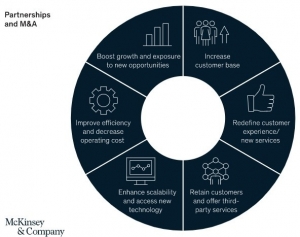McKinsey & Company is out with a new analysis of the future of banking in Asia and it may be an eye-opener for some.

Asian banks traditionally looked to the West for product and service ideas and business models. That’s definitely changed in the past five years as the region’s economy grew dramatically. Growth, profitability, and scale have been substantial in the past five years but the future in the region looks less certain.
A couple of highlights from the new McKinsey report – How Asia is reinventing banking for the digital age – show the growing size and pace of change for financial services in the region:
- More than 40 of the world’s 100 largest banks by assets are Asian and account for approximately 50% of the market capitalization of the top 100 banks globally.
- Asia has been the world’s largest regional banking market for a decade, generating pre-tax profits in excess of $700 billion and accounting for 37% of global banking profit pools in 2018.
- As the middle class grows to include two-thirds of Asian households, personal financial assets in the region will total $69 trillion by 2025, representing approximately three-quarters of the global total.
All very positive but not entirely the full picture in the region.
China’s powerful digital growth

Digital payments in China account for approximately 99% of the country’s non‑cash transaction volume and 45% of digital payments worldwide. Driving that digital tsunami are two of Asia’s best-known fintech innovators,
Alibaba’s Alipay and Tencent’s WeChat Pay, are building on their success in China and aggressively expanding across Asia and into the EU and even North America.
In South Korea in 2017, messaging app Kakao Talk launched a mobile bank called Kakao Bank. With 93% of South Korea mobile owners using the app, and it’s growing acceptance in Japan, Indonesia, the Philippines, and Vietnam, there’s nothing but expansion ahead.
Japan’s Rakuten has expanded into credit cards, digital banking, investments, and insurance in addition to its high-profile cashback company.
Fintech innovations are powering similar digital banking growth and integration in India, Singapore, and Malaysia.
Digital storms on the horizon
McKinsey sees potential clouds on the digital banking horizon however as previous fast growth in Asia slows, and this was before the coronavirus now impacting the region.

“While digitization and advanced data analytics are creating important opportunities for Asian banks, they also render long-standing business models obsolete, as new entrants compete aggressively to steal market share from incumbents. What is more, Asia is facing a tougher macroeconomic environment as growth slows, asset quality declines, and uncertainty about the macroeconomic outlook increases. The storm over Asia is gaining force, and banks must act quickly to counter attackers stealing market share,” the report says.
Banking industry annual revenue growth has dropped from double digits to just 5% between 2014 and 2018, a substantial decrease from the earlier salad days.
McKinsey also notes Asia’s percentage of global bank profits has dropped from nearly one-half in 2010 to one-third of global bank profits.
“If, as forecasts suggest, GDP growth continues to lose steam across emerging Asia, banks will be challenged to find new avenues of growth and will likely have to deal with deteriorating asset quality and rising risk cost. Already in 2018, risk cost provisions for Asia rose to approximately 0.30 percent, the highest level of loan losses for the region since 2002,” McKinsey says.
“Open banking” is taking hold

Across Asia, “open banking” is spreading. In India, non-bank operators can access the United Payments Interface (UPI). Hong Kong and Singapore have introduced new guidelines and licensing for digital-only banks.
Australian and Singapore require banks to provide open access to allow qualified third-party service providers to link to banking systems to access account information and initiate transactions on behalf of customers.
“We expect that as regulators consider ways to promote lower costs and better products for consumers, as well as improved system efficiencies and controls, open banking will likely become the norm in most Asian markets,” McKinsey predicts. And banking consolidation is likely ahead.
Asian banks are facing the prospect of having to disrupt themselves by shifting quickly from traditional to new digital models, acquiring new customers faster, dealing with shrinking margins and finding new ways to grow market share.
Fintech’s critical role

McKinsey says Asian banks must leverage new tools and technology including digitization, advanced data analytics, AI and robotics in order to support growth, new customer acquisition, scale, and efficiencies.
Retail lending in Asia totaled $12.8 trillion in 2018 and is on track to reach $21.2 trillion by 2025. SME loans are expected to grow at 9% annually between $23 trillion by 2025.
McKinsey also suggests partnerships, mergers, and acquisitions are other ways Asian banks will look to grow and achieve scale in the region and beyond.
Turbulence, innovations and faster banking digitization will be the developments to watch going forward in Asia.
The full McKinsey & Company report Future of Asian banking: How Asia is reinventing banking for the digital age can be downloaded here.

